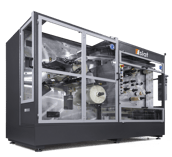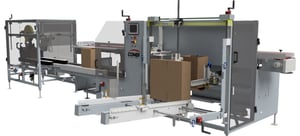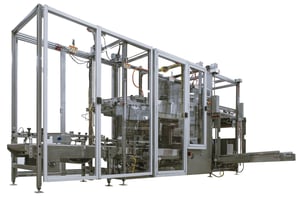Every year, we install more and more robotic packaging solutions for our customers.
Many of those installations started off as inquiries for traditional automation, and we were able to show them why a robotic cell would be a better solution for their specific situation.
That doesn’t mean robotics are always the answer. But the fact is, industrial robots are more accessible and beneficial than ever.
So why do many businesses assume robots aren’t for them?
Here are the five most frequent misconceptions about robotic packaging solutions that Drew Wadian, senior robotics engineer at Combi Packaging Systems, hears from customers and prospects.
We’re too small for robotic case packing
“Small shops tend to be apprehensive about spending money on automation in the first place,” Wadian says. “But we live in a world now where it’s automate or die. Businesses have to invest in the future through automation or you’re going to get run out of your own market position by someone else who does. When smaller companies tell us they aren’t ready for robotics, we show them how we can help them make that transition—and it’s a lot less difficult than they expect.”
Sometimes, the concern about size is less about revenue than about floor space. “That’s where robots really shine,” Wadian says. “We can lay out a robotic cell with a custom footprint because you don’t need mechanical connections between each piece of equipment. You can really wedge stuff in there.”
Packaging robots are too expensive
This may be the most pervasive myth about robotics in packaging. People think that unless you’re running a large-scale operation, the initial cost of robotics is too high to deliver ROI in a reasonable time frame.
Robotic solutions do require a larger initial capital investment than mechanical automation. “But when you factor in labor savings, increased productivity and reduced maintenance expense, the payback period for robotics is usually around 12-18 months—very similar to traditional packaging machinery,” Wadian says.
Robots are especially valuable for packing cases and palletizing for shipment, but can be programmed to do just about any end-of-line packaging job.
Industrial robots are too complicated
In the past, running industrial robots required specialized skills in programming and maintenance that most companies just don’t have. But the systems have advanced and are far more user-friendly today, according to Wadian.
“The complexity really depends on your integrator,” he says. “If you have the right integrator, your machine operator should be able to walk up to the robotic cell, push a button and make it run. That’s my job—to deliver one-touch functionality.”
Our production runs are too short to make robotics viable
“This is really a concern about flexibility, and that’s probably the single biggest selling point for robotics,” Wadian says.
“With a piece of mechanical equipment, if you want to change the work it does, you’ll have to swap out parts and may need to reengineer how it connects with other machines in the packaging line. And you’ll have to shut down the line while you’re making the change,” Wadian says. “Meanwhile, you can change the work a robot does through programming alone, and you can upload the changes while the robot is going about its other work. Once the programming is set, changeovers are fast and easy; you’re literally pushing a button on a menu.”
Recently, Wadian worked with a manufacturer of specialized adhesive tape that needed a packaging line to place eight rolls of tape onto a flat tray, and then stack the trays into a case. While engineering that solution using traditional case packing machinery, the customer wondered if it could also be used for packing some of its other products.
“The system was designed to handle one product of a specific dimension, but these other items were different sizes,” Wadian says. “So we redesigned the cell to include a robotic arm. A vision system allowed the robot to pick up items of different sizes. The whole solution cost more than what was originally specified, but it can handle six different products instead of just one. It really shines compared to a standalone machine.”
Finally, Wadian says, if needs change so much that the robot isn’t required for its original purpose, you can move it to another location in the operation and change its function.
Packaging robots are difficult to maintain
The expected life cycle of a robot is eight years without being overhauled. And Wadian says they can last far longer if the system is designed for longevity.
“It’s important for the integrator to do that work up front,” Wadian says. “I can show you the duty values and cycles the robot is going to experience based on the work you have planned for it. And from that, we can predict the lifespan with really good accuracy. I want to make sure that the cell running at 100 percent is going to last more than eight years.”
Robotic packaging solutions generally offer a faster startup than traditional machinery, and they have fewer components, “so there’s less to break or wear out. There’s less opportunity for failure,” Wadian says. “Our service department has way more service on traditional pieces and equipment than they do robotics cells.”
So if you’re looking for a single takeaway, Wadian suggests this: Don’t be afraid to invest in robotic automation for your packaging processes. It’s not as scary as you think, and it will pay off in more ways than you expect.
Do you have a packaging need that’s keeping you up at night? Contact Combi Packaging Systems to see what creative solutions we have to offer.







.png?width=161&name=ProWrap%20(1).png)


